This Blu-ray title is currently available from the Scream Factory line of distributor Shout! Factory.
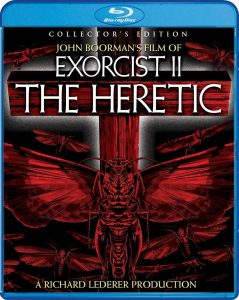 As everyone reading this knows, The Exorcist (1973) is considered a landmark horror film. It told the story of an innocent child’s demonic possession and the attempts by two priests to free the girl from the supernatural hold of her tormentor. This unusual battle between good and evil was presented in a graphic, visceral and incredibly tense manner (at least, for its day).
As everyone reading this knows, The Exorcist (1973) is considered a landmark horror film. It told the story of an innocent child’s demonic possession and the attempts by two priests to free the girl from the supernatural hold of her tormentor. This unusual battle between good and evil was presented in a graphic, visceral and incredibly tense manner (at least, for its day).
Exorcist II: The Heretic followed a few years later and was not only panned by both critics and audiences, it was downright hated. Since that time, the film has slowly developed a fan following… albeit for various different reasons. It seems the movie now has a group of defenders, as well as other who still see it as a jumbled mess, yet admire aspects of the project because of its brazen bizarreness and idiosyncrasies.
Now Shout! Factory, have dusted off the film and given it four-star treatment. It arrives on Blu-ray for the first time as a “Collector’s Edition” that contains two versions of the film, with new 2K scans of the original theatrical cut and the truncated version (which was created immediately after its disastrous opening weekend) which played internationally and was later released on home video. The 2-disc set also includes multiple commentaries, interviews and numerous other bonuses – no matter what you think of the film itself, this is a superb package.
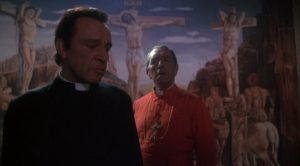 Set a few years after the events of the original film, Father Philip Lamont (Richard Burton) is assigned to investigate the death of Father Merrick (Max von Sydow), which occurred during the exorcism of Regan MacNeil (Linda Blair). It’s an already a difficult task that is further complicated by the priest’s crisis of faith and disdain for his superiors at the Vatican. The trail leads him to Regan, now a teenager living in New York and being monitored by psychiatrist Dr. Gene Tuskin (Louise Fletcher). Tuskin works at a very odd clinic using experimentation into psychic abilities as a treatment option. As one might expect, Regan is still haunted by the demon Pazuzu that once possessed her. She and Lamont soon form a telepathic bond and heads to Africa to meet Kokumo (James Earl Jones) in the hopes of ending the entity’s sinister influence.
Set a few years after the events of the original film, Father Philip Lamont (Richard Burton) is assigned to investigate the death of Father Merrick (Max von Sydow), which occurred during the exorcism of Regan MacNeil (Linda Blair). It’s an already a difficult task that is further complicated by the priest’s crisis of faith and disdain for his superiors at the Vatican. The trail leads him to Regan, now a teenager living in New York and being monitored by psychiatrist Dr. Gene Tuskin (Louise Fletcher). Tuskin works at a very odd clinic using experimentation into psychic abilities as a treatment option. As one might expect, Regan is still haunted by the demon Pazuzu that once possessed her. She and Lamont soon form a telepathic bond and heads to Africa to meet Kokumo (James Earl Jones) in the hopes of ending the entity’s sinister influence.
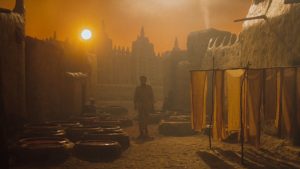 To be blunt, if I were to assess my feelings about the theatrical cut, I’d fall into the second category of enthusiasts who think that it doesn’t work but admire its strangeness. It is certainly a gorgeous-looking movie with great cinematography. Many of the film’s locations were built on the Warner Brothers studio backlot, recreating exteriors in Africa in a stylized yet attractive manner, with several elaborate segments involving swarms of raging locusts. The insect shots are incredible as well, with images shot from behind a real bug as it flies over various environments. Additionally, there are stunning vistas from the top of a Manhattan skyscraper involving a character who almost falls off the edge. From beginning to end, this is one amazing film to look at. Additionally, the score from Ennio Morricone is memorable, particularly with the wild music cues created for Pazuzu.
To be blunt, if I were to assess my feelings about the theatrical cut, I’d fall into the second category of enthusiasts who think that it doesn’t work but admire its strangeness. It is certainly a gorgeous-looking movie with great cinematography. Many of the film’s locations were built on the Warner Brothers studio backlot, recreating exteriors in Africa in a stylized yet attractive manner, with several elaborate segments involving swarms of raging locusts. The insect shots are incredible as well, with images shot from behind a real bug as it flies over various environments. Additionally, there are stunning vistas from the top of a Manhattan skyscraper involving a character who almost falls off the edge. From beginning to end, this is one amazing film to look at. Additionally, the score from Ennio Morricone is memorable, particularly with the wild music cues created for Pazuzu.
It’s the screenplay and behavior of the characters is where things get really wonky. In order to differentiate itself from its predecessor, the filmmakers approached the material very differently, attempting a more cerebral film. I certainly understand the metaphors being attempted and this technique may have been effective if handled properly. However, there seem to be an overabundance of themes introduced. This, along with the exaggerated and at times over-the-top nature of events create some jarring and unintentionally humorous juxtapositions.
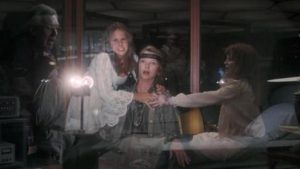 For example, much of this tale revolves around a goofy-looking contraption called a “synchronizer” that is used to form telepathic links between the characters. Frankly, the device looks just as ridiculous now as it did back in the day. It also doesn’t help matters that the cast are forced to put wires and gizmos on their heads and then stare at each other with amusingly cross-eyed, labored and even blank expressions; large early sections of the film involve these bits of psychic connectivity and it’s very hard not to find absurd in the extreme. In fact, these bits are downright hilarious.
For example, much of this tale revolves around a goofy-looking contraption called a “synchronizer” that is used to form telepathic links between the characters. Frankly, the device looks just as ridiculous now as it did back in the day. It also doesn’t help matters that the cast are forced to put wires and gizmos on their heads and then stare at each other with amusingly cross-eyed, labored and even blank expressions; large early sections of the film involve these bits of psychic connectivity and it’s very hard not to find absurd in the extreme. In fact, these bits are downright hilarious.
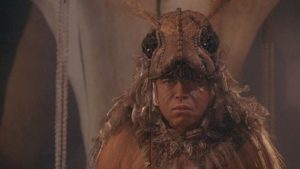 This story leads to various other plot-holes as to why psychic connections are made between certain characters but not others. And there are few explanations for the truly weird and difficult-to-relate to reactions and motivations of the leads (Lamont in particular). The numerous questions raised aren’t answered and many strange responses to events distanced this viewer and emphasized the incongruity. Other issues revolve around the demonic force of Pazuzu. When the leads aren’t straining their faces, most of the action takes place within the mind and involves visions of locusts. While there are a few creepy and moody moments that use these elements, the demonic antagonist doesn’t ever feel like a threatening entity.
This story leads to various other plot-holes as to why psychic connections are made between certain characters but not others. And there are few explanations for the truly weird and difficult-to-relate to reactions and motivations of the leads (Lamont in particular). The numerous questions raised aren’t answered and many strange responses to events distanced this viewer and emphasized the incongruity. Other issues revolve around the demonic force of Pazuzu. When the leads aren’t straining their faces, most of the action takes place within the mind and involves visions of locusts. While there are a few creepy and moody moments that use these elements, the demonic antagonist doesn’t ever feel like a threatening entity.
Director John Boorman is incredibly talented and has made some incredible movies like Deliverance, Excalibur and Hope and Glory. This project was in the middle of a very weird phase in his career that included the equally nutty Zardoz and has a similar feel. Like the previously referenced title, this movie all comes across as a bit like a crazed fever dream and never gels together in a coherent manner. Fortunately, while the film doesn’t work as intended, it is anything but boring. In fact, it’s entertainingly bizarre and this perhaps is part of its enduring appeal (at least in some circles).
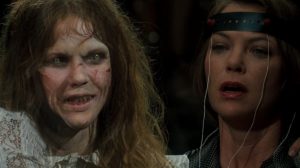 The new scan of the feature is excellent, correcting many of the colors issues found on previous DVD and VHS versions. Part of what makes this particular release so special is that it contains two different versions of the movie. Boorman’s post-premiere alterations make for an even odder experience; the short version includes a prologue, some alternate versions of scenes and an outright change of the ending. It’s intriguing to see how a rash reworking of the film resulted in an even choppier, more incongruous effort. At least the slightly more coherent (I’m being a bit generous with that comment) 118 minute cut was also salvaged and looks just as sharp and impressive as the shorter version.
The new scan of the feature is excellent, correcting many of the colors issues found on previous DVD and VHS versions. Part of what makes this particular release so special is that it contains two different versions of the movie. Boorman’s post-premiere alterations make for an even odder experience; the short version includes a prologue, some alternate versions of scenes and an outright change of the ending. It’s intriguing to see how a rash reworking of the film resulted in an even choppier, more incongruous effort. At least the slightly more coherent (I’m being a bit generous with that comment) 118 minute cut was also salvaged and looks just as sharp and impressive as the shorter version.
There are some phenomenal extras here as well, in which various participants and film scholars dissect the movie and present their own opinions on the material. The longer cut features two new commentaries from director John Boorman, project consultant/super-fan Scott Bosco, as well as fresh interviews with star Linda Blair and one of the editors about the movie.
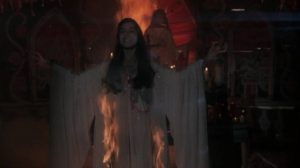 The information revealed is fascinating and at times extremely contradictory, leading to further speculation about what really happened. Bosco appears to be the film’s biggest supporter and tries to make a case for it being misunderstood by critics and moviegoers… who simply didn’t understand all of its intellectual nuances. It’s really a tough sell, but along the way Bosco offers some fun background information. While director Boorman also defends his work, even he ultimately admits by the close there was probably far too much material packed into the movie and implies that it could have used some streamlining.
The information revealed is fascinating and at times extremely contradictory, leading to further speculation about what really happened. Bosco appears to be the film’s biggest supporter and tries to make a case for it being misunderstood by critics and moviegoers… who simply didn’t understand all of its intellectual nuances. It’s really a tough sell, but along the way Bosco offers some fun background information. While director Boorman also defends his work, even he ultimately admits by the close there was probably far too much material packed into the movie and implies that it could have used some streamlining.
Linda Blair also gives interesting insight into the film. She states that most of the cast signed on after reading an early draft of the screenplay, one that she believed was very strong. The actress states that the movie was rewritten five times over the course of pre-production and that too many cooks ultimately spoiled the broth. By the time they shot it, the project barely resembled the first draft. She states that she did her best, but was extremely disappointed by the changes and felt the feature’s failure hindered her career.
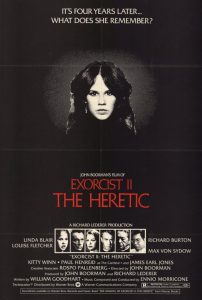 Bosco throws some shade on Blair during his audio commentary, claiming that the rumors about Richard Burton drinking in excess were false, that he was a consummate professional, and that the young actress was a real problem on the set with her lateness. In her interview, Blair mentions that Burton was genial and that she had one incredible moment with him on camera, but that he otherwise had difficulty with lines and during close-ups read them off of cue cards. Even Boorman, who generally avoids controversy on his track, admits that while he liked Burton, the actor was miscast and comments that he found the actor to be very distant and detached during the production. So make what you will of all of those opinions (I could be wrong, but I tend to believe Blair’s first-hand accounts).
Bosco throws some shade on Blair during his audio commentary, claiming that the rumors about Richard Burton drinking in excess were false, that he was a consummate professional, and that the young actress was a real problem on the set with her lateness. In her interview, Blair mentions that Burton was genial and that she had one incredible moment with him on camera, but that he otherwise had difficulty with lines and during close-ups read them off of cue cards. Even Boorman, who generally avoids controversy on his track, admits that while he liked Burton, the actor was miscast and comments that he found the actor to be very distant and detached during the production. So make what you will of all of those opinions (I could be wrong, but I tend to believe Blair’s first-hand accounts).
The third commentary track on the shorter cut includes another film writer, Mike White of The Projection Booth Blog. Overall, his comments are probably closest in line with my own, acknowledging the various gaps in logic and other issues with the movie, while still showing plenty admiration for its technical expertise and uniqueness.
The release includes other great extras too. Just about every still ever shot in connection with the movie and all of the posters are compiled as a bonus, and the movie contains an interesting early preview trailer made during production as well as a nifty theatrical trailer.
Whatever you may think about the final product, this Blu-ray of Exorcist II: The Heretic is fantastic, presenting this beautifully shot but insane movie with exceptional image quality. The bonuses will keep one captivated too, with varying opinions and thoughts on the production by participants and fans. If you’re a horror fan with a taste for the surreal and own the other films in this franchise, you definitely owe it to yourself to pick this title up. This is the best release it has ever or likely will ever receive and comes recommended.


